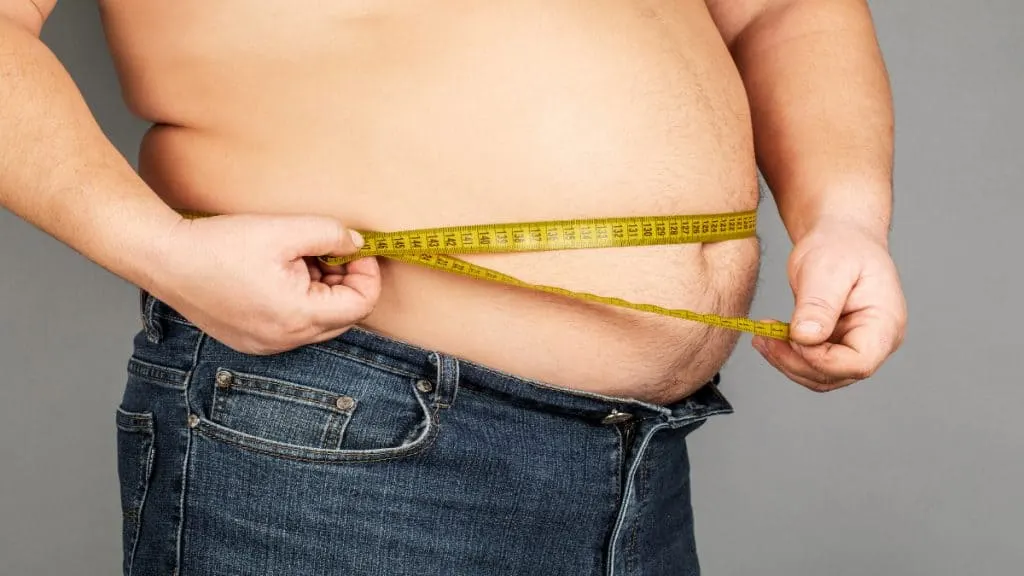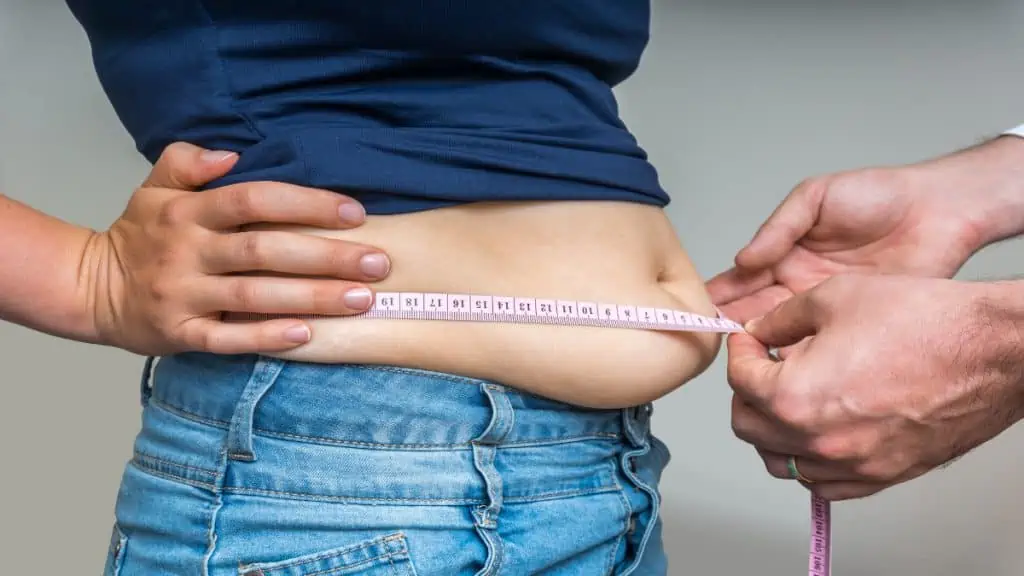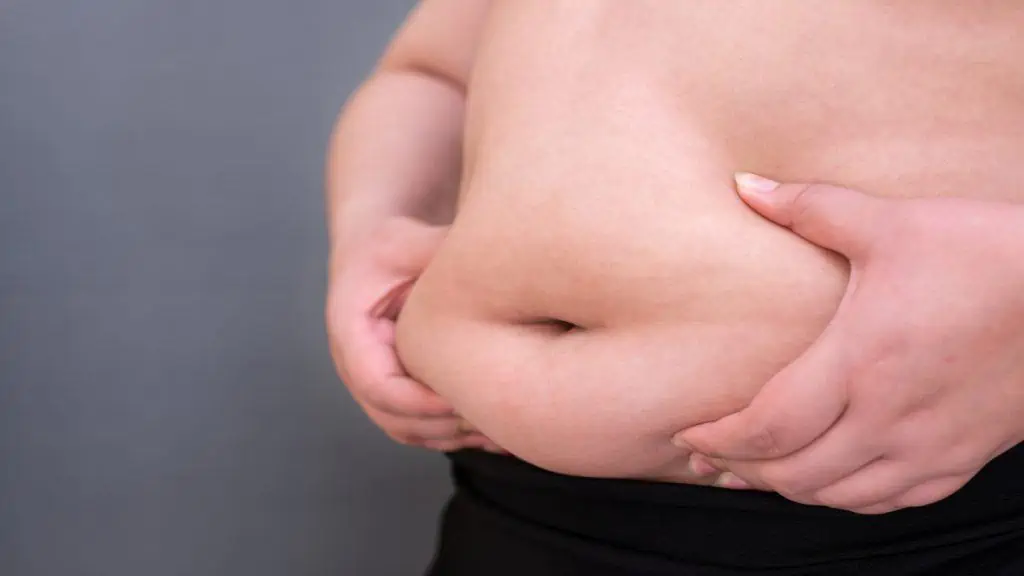A 43 inch waist is 3 inches bigger than the average male waist size and around 5 inches larger than average for an adult female.
This might not sound too bad—and it isn’t compared to larger measurements—but when you consider that the average is already too big, you begin to understand that you simply can’t live in your best health while having a 43 in waist.
This guide explains the dangers of having a 43″ waist and then gives you some practical stomach-slimming tips that you can easily implement in your lifestyle today.
Related Waist Size Guides:
- 40 inch waistline
- 41 inch waistline
- 42 inch waistline
- 44 inch waistline
- 45 inch waistline
- 46 inch waistline
- 47 inch waistline
- 48 inch waistline
- 49 inch waistline
How big is a 43 inch waist for a man?

For a man of just about any height and build, a 43 inch waist is too big for a male to live in good health. Indeed, research shows that having an excessively large waist size as a man or woman leads to an increased risk of metabolic syndrome (heart disease, high blood pressure, stroke, diabetes). [1]
While only a few inches bigger than average, 43 inches is still well above the frequently recommended 35-37 inch upper limit for a man’s waistline.
The silver lining is that many men have waists that are far greater than 43 inches in circumference. This doesn’t mean that you should be complacent with your diet and exercise regime, but it does mean that your current position isn’t anywhere near as bad as it could be.
Later on, you’ll learn how to shed your stomach fat by implementing a few simple dietary changes. You’ll also discover the most effective kind of exercise for burning body fat while targeting your abs.
How about for a woman?

A 43 inch waist is too big for a woman to live in optimal health. While you can certainly be happy with your body without being slim, you simply can’t achieve anywhere close to ideal health when you have such an excess of body fat.
Excess stomach fat—much more so than having extra leg or hip fat—is especially dangerous to your health because it increases the likelihood of you having visceral fat. This kind of fat can wrap around your internal organs and increase your risk of conditions like high blood pressure, heart disease, stroke, and diabetes.
Of course, some women naturally store more body fat around their waistline than others. But even a genetic disposition towards a certain fat storage distribution is unlikely to explain a large excess of stomach fat.
Luckily, a 43 inch waistline isn’t as bad as it could be—you’ve identified the issue at a good time.
As you’ll learn in just a minute, weight loss is much more simple (in theory) than it’s made out to be. To get the fat loss ball rolling, all you need to do initially is put your body in an energy deficit.
Why is having a 43″ waist bad?

Although some people feel self-conscious about having a 43 inch waist, it’s entirely possible to be happy with your body without being slim. Indeed, many slim and muscular people are unhappy with their bodies, which just shows you that what you think about yourself is the most important thing.
As for your physical health, however, no person can have a 43 inch waistline and enjoy their best health.
Health care costs are rising, and researchers note that one reason for this is an increased waist circumference at various BMI levels. [2] In other words, if you have an excessively large stomach, then you’re more likely to require medical treatment for various medical conditions and diseases.
This is why you should nip your weight gain in the bud and seek to slim your stomach. By following a simple exercise regime and making better food choices, the only outcome is a healthier body and a smaller waistline.
How can you slim your 43 in waist naturally?

As mentioned, you need to be in an energy deficit if you want to lose weight and slim your waist. Much of the time, getting your body in an energy deficit simply means eating fewer calories than your body needs to maintain its mass.
Additionally, you can also create an energy deficit by increasing your activity level. Most of the time, however, your best bet for losing weight is to both reduce your calories and increase your activity level. So if you usually eat 2500 calories per day, drop them down to 2000.
Making better food choices boils down to eliminating processed foods and eating nutrient-dense whole foods instead. There are loads of options here; salmon and eggs, for example, contain muscle-sculpting proteins and also give your body a good dose of fat, which is necessary for maintaining optimal hormone levels.
Make sure to eat various fruits and vegetables so that your body receives plenty of health-boosting vitamins and minerals. Ideally, you should get some fruit and veg with every meal.
On the workout side of things, your best bet is to perform full-body movements like burpees, mountain climbers, and squats because these kinds of exercises burn the most calories per minute.
You can definitely do isolation exercises as well if you so desire, but for the biggest calorie-burning bang for your buck, stick to full body drills most of the time (they’ll improve your cardiovascular fitness as well).
The verdict: Can anyone reduce their 43 inch waistline?

Some people naturally have a harder time losing weight than others. And yet, just about every able-bodied person is capable of losing at least some weight.
As you now know, successful weight-loss boils down to being in an energy deficit, which you can achieve by increasing your activity level and reducing your calories.
In addition to this, make sure to get enough restful sleep and keep your stress levels low, as neglecting either of these variables can affect your weight loss progress by messing up your hormones. [3]
Also, don’t expect to shed your 43 inch waist overnight. If you’re losing one pound per week (or even slightly more initially), that’s really great and is a massive indicator that you’re on the path to better physical health.
References
- Beydoun, M. A., Fanelli Kuczmarski, M. T., Wang, Y., Mason, M. A., Evans, M. K., & Zonderman, A. B. (2010). Receiver-operating characteristics of adiposity for metabolic syndrome: the Healthy Aging in Neighborhoods of Diversity across the Life Span (HANDLS) study. Public Health Nutrition, 14(1), 77–92. https://doi.org/10.1017/s1368980010002648
- Højgaard, B., Gyrd-Hansen, D., Olsen, K. R., Søgaard, J., & Sørensen, T. I. A. (2008). Waist Circumference and Body Mass Index as Predictors of Health Care Costs. PLoS ONE, 3(7), e2619. https://doi.org/10.1371/journal.pone.0002619
- Holder, J. (n.d.). Ask The New York Times. New York Times. https://www.nytimes.com/ask/answers/best-way-to-address-belly-fat

